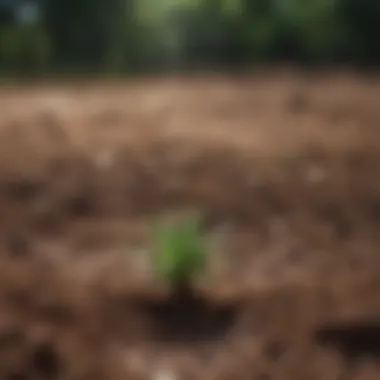Optimal Timing for Activating Your Sprinkler System


Intro
Activating your sprinkler system at the right time is essential for maintaining a healthy garden. It requires more than just remembering to turn on the tap. This process involves understanding various factors that greatly affect the health of your lawn and the efficient use of water.
Many homeowners strive to keep their gardens lush and green while also being mindful of sustainability. Therefore, knowledge about soil moisture levels, local climate patterns, and the timing of seasonal changes can help form effective watering strategies. This article aims to delve into these critical elements, providing readers with insights that can lead to informed decisions about the optimal performance of sprinklers.
Understanding the environmental dynamics is not merely about keeping grass alive. It directly relates to water conservation efforts. When one recognizes they can adjust their watering schedules based on the weather, for instance, it leads to significant resource savings and enhances the overall vitality of outdoor spaces.
In this guide, we will explore essential considerations, including:
- Soil Moisture Levels: Assessing how much water your soil currently retains is vital.
- Seasonal Weather Patterns: Understanding how changing weather affects your watering schedule.
- Regional Climate Variations: Recognizing that different areas require different care techniques.
This exploration will furnish you with strategies to achieve a balanced approach between efficient water use and the needs of your garden.
Furthermore, this guide addresses relevant tips for converting your insights into practical actions. Thus, creating a sustainable environment will reflect the conscientious effort on the part of the homeowner.
"The best time to plant a tree was twenty years ago. The second best time is now."
This adage reflects the essence of taking timely actions regarding garden maintenance.
Understanding Sprinkler Systems
Understanding sprinkler systems is foundational to optimizing their use and achieving a healthy garden. The way these systems work plays a crucial role in water distribution, helping to maintain optimal soil moisture. These systems vary in design and functionality, impacting how effectively they deliver water to different types of vegetation.
There are several benefits to comprehending sprinkler systems. Firstly, knowing the types and components can lead to more efficient watering practices. Homeowners can make informed choices about the systems that suit their landscaping needs best. Equally, a grasp of how these systems operate allows for better maintenance, ultimately prolonging the lifespan of the equipment.
Overview of Sprinkler System Types
Sprinkler systems generally fall into several categories, each designed for specific needs. Some of the prominent types include stationary, oscillating, and rotating sprinklers. Each type has distinct features:
- Stationary Sprinklers: They are fixed in one position, delivering water in a set pattern. These are ideal for small flower beds.
- Oscillating Sprinklers: These have a moving arm that produces an oscillating spray. They are better suited for rectangular areas like lawns.
- Rotating Sprinklers: Known for their ability to cover larger areas, they rotate their spray pattern. This type is effective for wide grassy spaces.
Understanding these types allows homeowners to select the right system based on landscaping requirements, ensuring efficient water use.
Components of a Sprinkler System
To fully grasp how sprinkler systems work, it's important to be aware of the key components that comprise them. Typical system parts include:
- Water Source: This can be a hose, tap, or irrigation canal.
- Pump: Elevates water pressure to ensure even distribution.
- Pipe Network: Delivers water from the source to the sprinklers.
- Sprinklers: The devices that release water onto the lawn or garden.
- Timers and Controllers: Manage the watering schedule, often allowing automation.
These components must work in harmony to optimize water distribution, and recognizing their individual functions can assist in troubleshooting and maintenance.
The effectiveness of a sprinkler system hinges greatly on understanding its components and types, ultimately leading to better water conservation.
The Role of Soil Moisture
Soil moisture plays a foundational role in maintaining the health and vitality of any garden or lawn. Understanding its dynamics is crucial for homeowners aiming to optimize their sprinkler system. Adequate moisture levels influence the growth of plants and soil ecology, creating a thriving outdoor space. This section explores the significance of soil moisture, factors affecting it, and the benefits of monitoring moisture levels effectively.
Examining Soil Moisture Levels
Soil moisture levels can vary greatly depending on several factors. These include soil type, weather conditions, and plant demands. Sandy soils tend to drain quickly, while clay retains water longer. Evaluating these properties allows for better irrigation management.
One way to examine soil moisture is by digging a small hole in the garden. Observing wet or dry states at varying depths gives insight into the moisture profile. Additionally, plant indicators like wilting leaves can suggest water issues. Understanding these dynamics empowers better decisions when activating the sprinkler system.
Key factors influencing soil moisture include:
- Recent rainfall: Check local weather reports to gauge the impact of precipitation on moisture levels.
- Evapotranspiration: High temperatures or windy conditions can increase moisture loss from the soil.
- Soil compaction: Compacted soil restricts water penetratio, resulting in uneven moisture distribution.
Tools for Measuring Soil Moisture


Several tools exist for measuring soil moisture with varying degrees of precision. Reliable measurement tools help inform when to activate the sprinkler system. Here are some options:
- Soil Moisture Meters: These devices measure moisture levels directly, providing immediate feedback on soil conditions. They can be inserted into the ground to read the moisture levels at various depths.
- Tensiometers: These instruments measure soil water tension, providing insights into the energy needed for plant roots to extract water. This tool is more complex but offers deeper insights.
- Capacitance Sensors: These can provide continuous readings and can be connected to automated irrigation systems for precise control.
Using these tools can guide decisions, prevent overwatering, and ensure that outdoor spaces receive just the right amount of moisture.
Keeping an eye on soil moisture not only enhances the health of your lawn but also fosters responsible water usage.
Seasonal Considerations
Understanding seasonal considerations is vital for achieving optimal results in lawn care and water conservation. Each season brings unique challenges and specific needs, which can greatly influence the effectiveness of your sprinkler system. This guide will delve into the nuances of each season, highlighting the best practices and adjustments necessary to maintain healthy landscaping while minimizing water usage.
The benefits of adhering to seasonal guidelines are multifaceted. Firstly, aligning watering schedules with seasonal changes helps to sustain soil health. Secondly, it prevents overwatering or underwatering, both of which can adversely affect your plants. Lastly, making use of seasonal insights fosters a more sustainable approach to gardening, ensuring you use resources thoughtfully and efficiently.
Spring Activation: Best Practices
Spring marks the awakening of many plants after winter dormancy. As temperatures rise, activating your sprinkler system becomes imperative to support new growth. The best practices for spring activation start with assessing soil moisture levels. Before watering, check if the soil is dry, particularly in the upper few inches. This ensures that you are not watering unnecessarily.
When you do activate the system, start with shorter watering cycles. This allows water to infiltrate the soil gradually without causing runoff. Moreover, consider watering early in the morning to minimize evaporation loss. This approach helps maintain adequate moisture levels in the soil while conserving water.
Summer Watering Needs
Summer brings heightened temperatures and increased evaporation rates. During this season, your lawn will require more water to remain robust and healthy. Adjust your sprinkler system accordingly. Increase the frequency of watering sessions, typically early in the morning or late in the evening to maximize absorption.
Consider the type of grass and its specific requirements. For instance, warm-season grasses usually thrive on higher moisture levels during peak summer heat. Additionally, calibrate your system to deliver water at deeper levels. This encourages root growth and resilience against drought conditions.
Autumn Adjustments
As temperatures begin to drop, it's time to reassess watering practices. Autumn is a transition period, making it crucial to adjust the sprinkler system accordingly. The needs of your lawn will shift, often requiring less frequent watering than in summer.
Focus on deeper, less frequent watering sessions to promote root development before winter arrives. This preparation strengthens the lawn’s resilience to cold weather. Monitor rainfall during this season, as nature might supplement your watering needs. Adjust the sprinkler timing to avoid overlap with natural precipitation, thus conserving water.
Winter Shutdown and Maintenance
Winter brings a unique set of challenges for sprinkler systems. Most regions experience colder temperatures that necessitate shutting down the system to prevent damage. The first step is to drain your sprinkler system to eliminate any residual water, reducing the risk of freezing and bursting pipes.
Maintenance during winter months is essential. Inspect the system for any leaks or issues that could impede function in spring. Conduct a thorough cleaning of sprinkler heads and filters to ensure they are in optimal condition when the system is reactivated. Proper winter management not only preserves the integrity of your sprinkler but also expedites the spring activation process.
Climate and Regional Variations
Understanding climate and regional variations is essential for optimizing the use of sprinkler systems. Climate influences how much water your garden needs and when it should be applied. The geographical area you reside in can shape watering schedules significantly and understanding this helps in maximizing water efficiency and promoting healthy plant growth. This section discusses how local climate and weather patterns affect irrigation practices and provides insights for effective sprinkler system operation.
Understanding Your Local Climate
Your local climate dictates a significant portion of your irrigation needs. Temperatures, humidity, and weather conditions all play key roles in deciding when to activate your sprinkler system. For instance, if you are in a region that experiences long dry spells during summer months, your watering requirements will differ from a cooler, consistently rainy area.
Factors to consider:
- Temperature fluctuations affect evaporation rates. In hot climates, water evaporates faster, increasing the need for regular watering.
- Humidity levels can also influence how often you need to use your sprinkler system. High humidity reduces evaporation, meaning you might need to water less.
- Seasonal changes impact plant growth. The growth phase of plants aligns with temperature and rainfall patterns, which affects when you should activate the system for optimal moisture.
Utilizing weather data, such as local forecasts, can aid homeowners in making informed decisions. For example, activating sprinklers before a predicted heatwave ensures that plants remain hydrated, while rain forecasts can help avoid overwatering.
Impact of Regional Weather Patterns
Regional weather patterns also necessitate a tailored approach to sprinkler system activation. A region known for frequent rain will require a different watering schedule than an arid zone. Understanding these patterns helps in conserving water and ensuring plants receive the necessary hydration.
Some important aspects to consider:


- Rainfall distribution throughout the year is critical. In areas with seasonal monsoons, it may be beneficial to reduce sprinkler use during heavy rain periods.
- Drought occurrences require adjustments in watering schedules. Homeowners must be vigilant and adapt their sprinkler usage during drought conditions to comply with local restrictions.
- Wind patterns can also affect sprinkler efficiency. In windy areas, water can be blown away from the intended area, leading to uneven distribution and wastage.
"Being aware of local rainfall patterns is crucial. It allows for better planning of watering schedules and reduces unnecessary water consumption."
Environmental Considerations
Understanding environmental considerations is essential in the context of activating your sprinkler system. Homeowners must balance the need for a healthy lawn with the natural limits of water resources. Efficient water use not only benefits gardens but also plays a crucial role in sustainability efforts.
Water Conservation Techniques
Implementing water conservation techniques is vital for optimizing sprinkler system operation. Several methods effectively reduce water wastage while still providing adequate hydration to plants. These techniques include:
- Drip irrigation: This method delivers water directly to the roots of the plants, minimizing losses through evaporation and runoff.
- Rainwater harvesting: Collecting rainwater can supplement your irrigation system and lessen dependency on municipal sources.
- Mulching: A layer of mulch helps retain soil moisture, reducing the need for frequent watering.
- Seasonal adjustments: Altering watering schedules based on monthly rainfall or extended forecasts ensures that you apply water only when necessary.
Each of these approaches contributes to a more sustainable gardening practice, aiding in the preservation of local water supplies.
Impact of Sprinklers on Local Ecosystems
Sprinklers can have significant effects on local ecosystems. Understanding this impact is important for responsible usage. Gerald installations can lead to unintended consequences such as:
- Soil erosion: Excessive watering can wash away fertile topsoil, weakening the land's productivity.
- Nutrient leaching: Overwatering can cause valuable nutrients in the soil to leach away, rendering the soil less fertile.
- Plant disease: Persistent wet conditions can foster the growth of mold and fungi, damaging plants.
To mitigate these effects, it is prudent to monitor the volume and frequency of watering. Being aware of the immediate environment and its health ensures that sprinkler systems contribute positively to local ecology.
Best Practices for Sprinkler System Operation
Maintaining an effective sprinkler system is essential for healthy lawns and gardens. Implementing best practices can help ensure that water is used efficiently while maximizing plant growth. Understanding how to operate your system correctly can lead to substantial savings in both water usage and costs.
Scheduling Efficient Watering Sessions
Scheduling watering sessions requires attention to time and frequency. Timing plays a pivotal role in ensuring that plants receive adequate moisture without wasting water. The early morning is typically the best time for watering. At this hour, evaporation is minimal, leading to better moisture absorption by the soil.
Consider implementing a schedule that adapts to seasonal changes. For instance, during hotter months, increase the watering frequency, while in cooler seasons, reduce it. This not only helps in conserving water but also enhances the effectiveness of each watering session.
Keep in mind factors like plant types and soil composition when scheduling. Deep-rooted plants may require less frequent but deeper watering, while shallow-rooted plants may benefit from lighter, more regular watering. Using a timer can simplify this process, ensuring that your system operates efficiently even when you are not available to monitor it.
Monitoring Weather Forecasts
Weather plays a significant role in determining when to water your garden. By monitoring weather forecasts, you can adjust your sprinkler system operations accordingly. Rain is a natural source of moisture; therefore, it’s wise to skip scheduled waterings when there is anticipated precipitation.
Use online applications for weather updates. These platforms provide real-time information and can often predict rainfall accurately. Several mobile applications can also connect to smart sprinkler systems, allowing adjustments to be made remotely.
Additionally, pay attention to local weather patterns, not just general forecasts. Understanding your area's climate variability can guide your watering schedule significantly. For example, in a region that experiences extended dry spells, more frequent watering may become necessary. Being proactive about weather changes can enhance water conservation efforts.
Proper scheduling and weather monitoring can reduce water waste and promote a healthier garden environment.
By following these best practices, homeowners can ensure the optimal operation of their sprinkler systems. This approach not only contributes to the health of gardens and lawns but also supports sustainable water usage and conservation efforts.
Common Mistakes to Avoid
Understanding the common mistakes related to activating your sprinkler system is crucial for maintaining a healthy garden and ensuring efficient water use. Avoiding these pitfalls not only saves water but also helps promote a healthier lawn. Many homeowners may overlook essential aspects, resulting in stressed plants or wasted resources. By identifying these mistakes, you can optimize your watering practices and enhance the sustainability of your outdoor spaces.
Ignoring Soil Needs
One critical mistake is ignoring the needs of your soil. Every type of soil has different water retention properties. For example, sandy soils drain quickly and may require more frequent watering, while clay soils retain moisture for longer periods. Failing to consider these variations can lead to improper watering schedules.
It's essential to assess the soil type and conditions regularly. Here are a few considerations:


- Conduct soil tests: Knowing your soil’s composition can inform your watering schedule effectively.
- Be attentive to soil moisture: Use moisture meters or probes to determine when your soil genuinely needs water. The goal is to water when the soil is dry but avoid wait too long, which will stress your plants.
Ignoring these factors can lead to poor lawn health, weed growth, and increased susceptibility to pests and diseases.
Overwatering or Underwatering
Another significant error is the balance between overwatering and underwatering. Striking the right amount of water is key to plant health. Overwatering can suffocate roots, leading to rot, while underwatering stresses plants and hinders growth. One way to determine the right approach is to set a watering schedule based on weather patterns and soil moisture.
Consider the following tips:
- Adjust watering frequency seasonally. During hot summers, lawns may need daily watering, while cooler months may allow for weekly sessions.
- Monitor rainfall: Keep track of local weather to adapt your watering schedule. If your area receives sufficient rain, such as a recent downpour, you might reduce your sprinkler usage.
- Check for run-off: If you see water running off the lawn instead of soaking in, decrease the duration of your watering.
A well-watered lawn enhances curb appeal and promotes ecological health. It is crucial to avoid extremes in watering practices.
Making these adjustments, based on careful observation of your lawn's condition, will lead to an effective and sustainable watering strategy.
Tools and Technologies for Effective Sprinkling
Understanding the tools and technologies available for effective sprinkling is vital in optimizing lawn care. These innovations allow homeowners to manage their watering efficiently, ensuring that the grass and plants receive the right amount of water at the appropriate times. This, in turn, promotes healthier lawns and gardens while conserving water, which is increasingly significant in today’s environment.
Two major developments in this field are smart sprinkler systems and mobile applications for monitoring watering schedules. Each of these contributes distinct benefits that can enhance garden maintenance.
Smart Sprinkler Systems
Smart sprinkler systems have revolutionized how various watering tasks are handled. These systems utilize advanced technologies such as sensors, timers, and weather data integration to optimize watering processes. For example, they can automatically adjust watering schedules based on rainfall and temperature, reducing water waste significantly.
The advantages of smart sprinkler systems include:
- Automation: Users can set their systems to operate without manual input, freeing up time for other tasks.
- Customization: Many smart systems can be tailored to the specific needs of the lawn or garden, helping in targeting areas that require more water.
- Remote Monitoring: Many models allow homeowners to control their sprinklers from mobile devices, providing oversight from anywhere.
It is also important to ensure that the installation is done properly. Homeowners should work with professionals if unsure about setup. This helps to maximize effectiveness by ensuring that the system covers all necessary areas uniformly.
Mobile Applications for Monitoring Watering
Mobile applications have become increasingly popular among gardening enthusiasts. These apps aid in managing irrigation routines by providing various functionalities that streamline the watering process. Users can track soil moisture levels, set schedules, and receive alerts about their watering needs through these platforms.
Some key features of these applications include:
- Soil Moisture Tracking: Most apps can integrate with sensors placed in the garden, providing real-time data on soil needs. This minimizes the risk of over or underwatering.
- Weather Alerts: Apps can send notifications based on weather forecasts to help homeowners adjust their schedules accordingly, ensuring the lawn gets watered at optimal times.
- User-Friendly Interfaces: Many applications offer intuitive designs that make it easy for anyone to navigate and use.
The End and Final Recommendations
In the journey of establishing and maintaining a healthy garden, the timing of your sprinkler system plays a crucial role. Through proper activation aligned with environmental indicators, you can effectively reduce water wastage while ensuring your plants receive adequate hydration. This article provides essential insights into optimizing your sprinkler system to meet your garden's needs. Understanding the dynamic interplay of soil moisture, regional climate variations, and seasonal weather patterns equips homeowners with the knowledge to make informed, responsible decisions.
The final recommendations stress the importance of regular monitoring. By staying in tune with changes in soil moisture and local weather conditions, you can adjust your sprinkler schedule accordingly. This not only supports the health of your landscape but also conserves a vital resource: water.
Moreover, automating your system with technology can further enhance efficiency. Smart systems, coupled with mobile applications, allow you to customize watering schedules based on real-time conditions. Adapting to these recommendations not only optimizes the functioning of your sprinkler system but also contributes to environmentally sustainable practices.
"A responsible approach to gardening encompasses both care for the environment and consideration of the ecological impact of your watering habits."
Key Takeaways
- Assess Soil Moisture Regularly: Regular checks ensure you know when to water. Use tools like soil moisture meters to gauge levels accurately.
- Monitor Weather Conditions: Stay informed about local rainfall and temperature changes. This knowledge helps in adjusting watering times effectively.
- Adapt Your System Based on Seasons: Different seasons require unique watering strategies. Tailor your approach according to seasonal needs to optimize plant health.
- Leverage Technology: Consider smart sprinkler systems that adjust according to weather data and soil conditions. This automation can greatly enhance efficiency.
- Practice Water Conservation: Be mindful of water usage, adopting techniques that minimize waste while still supporting your garden's vitality.
Encouragement for Sustainable Practices
Embracing sustainable gardening habits is vital in today's environment. Every decision you make regarding your watering system can reflect a commitment to ecological responsibility. Here are a few suggestions to promote sustainability:
- Educate Yourself: Stay updated on best practices for irrigation and water management. Knowledge is key to effective gardening.
- Implement Rainwater Harvesting: Consider installing systems to collect rainwater. This water can be used to nourish your garden without tapping into municipal resources.
- Use Native Plants: These plants typically require less water and are better adapted to local conditions, promoting a healthier ecosystem.
- Design Efficient Landscapes: Create landscape designs that maximize water retention, such as using mulch. These practices can significantly reduce your overall irrigation needs.
Taking small, deliberate steps towards sustainable practices significantly impacts both your garden's health and the environment.
Remember, responsible water management is not just a personal choice; it is a collective responsibility for the planet's future.







